Facial Injectables Market Size and Share
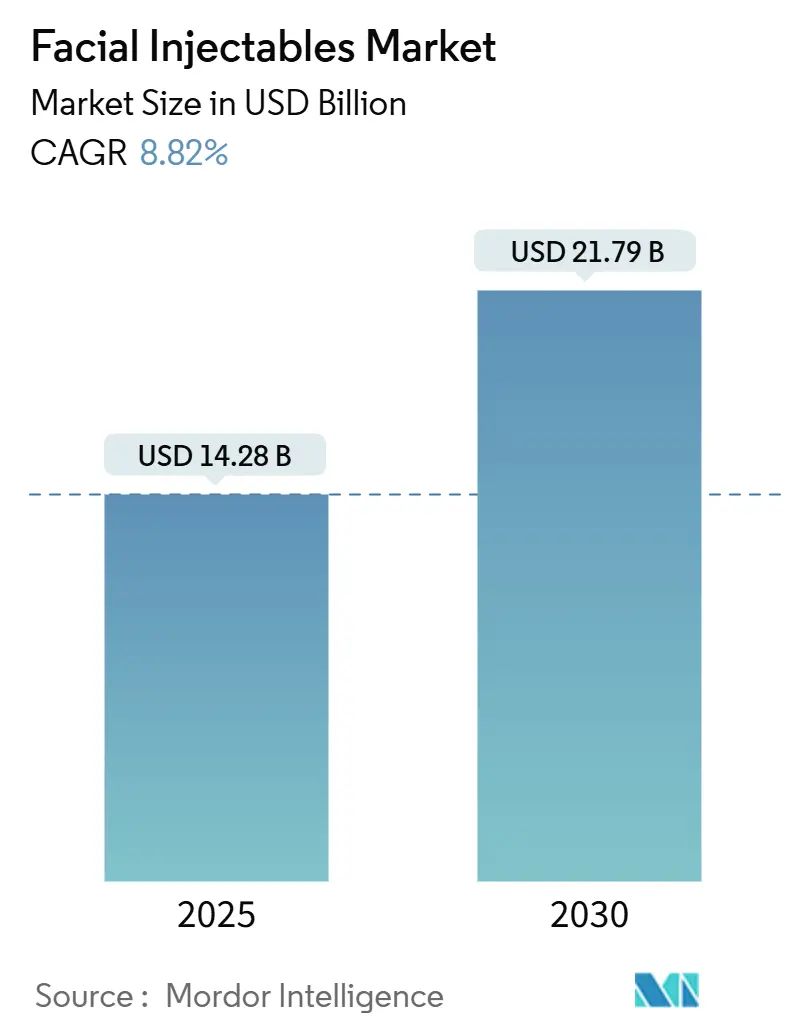
Facial Injectables Market Analysis by Mordor Intelligence
The facial injectables market is valued at USD 14.28 billion in 2025 and is forecast to reach USD 21.79 billion by 2030, advancing at an 8.82% CAGR. Growth remains steady as consumer demand for minimally invasive aesthetics rises and product science evolves to deliver longer-lasting, more comfortable results. Preventative neuromodulator use among younger adults, the emergence of regenerative injectables such as polynucleotides, and the integration of subscription programs that lift per-patient spend are expanding the addressable base. North America continues to generate the largest revenue pool, yet Asia-Pacific is outpacing all regions on the back of medical tourism and a growing middle class. Competitive intensity is climbing as established leaders acquire pipeline assets and smaller entrants pursue differentiated pricing and marketing aimed at Gen Z and male patients—the two fastest growing cohorts in the facial injectables market.
Key Report Takeaways
- By product type, botulinum toxin led with 56.10% facial injectables market share in 2024, while hyaluronic acid fillers are projected to grow at a 10.23% CAGR through 2030.
- By gender, women represented 80.76% of 2024 procedures, whereas the male segment is rising at a 10.04% CAGR to 2030.
- By application, facial line correction accounted for 32.63% of the facial injectables market size in 2024; face-lift indications are set to expand at an 11.18% CAGR in the same period.
- By end-user, clinics and aesthetic centers captured 54.32% of 2024 revenues; hospitals and ambulatory surgical centers are advancing at a 9.51% CAGR as they add cosmetic offerings.
- By geography, North America held a 38.75% share in 2024, but Asia-Pacific is forecast to post the fastest 10.89% CAGR through 2030.
Global Facial Injectables Market Trends and Insights
Drivers Impact Analysis
| Drivers | (~) % Impact on CAGR Forecast | Geographic Relevance | Impact Analysis |
|---|---|---|---|
| Social-media-fueled "Baby Botox" trend among Gen Z consumers | +1.8% | Global, with the highest impact in North America and Europe | Short term (≤ 2 years) |
| Cross-border aesthetic tourism boosting procedure volumes | +1.2% | Asia-Pacific, Europe, Middle East | Medium term (2-4 years) |
| Long-acting lidocaine-enhanced HA fillers improving patient throughput | +0.9% | Global | Medium term (2-4 years) |
| New indications approved for botulinum toxin products | +1.5% | North America, Europe, and developed Asia-Pacific | Long term (≥ 4 years) |
| Subscription-based MedSpa programs driving repeat spend | +1.1% | North America, Europe | Medium term (2-4 years) |
| Rise of regenerative polynucleotide injectables expanding product mix | +0.7% | Europe, Asia-Pacific | Long term (≥ 4 years) |
| Source: Mordor Intelligence | |||
Social-media-driven Baby Botox trend
Market momentum is buoyed by smaller-dose neuromodulator injections that appeal to Gen Z consumers seeking subtle, preventative results. Influencer posts on TikTok and Instagram have removed stigma around early intervention, and procedural volume among patients aged 20-29 rose 71% between 2019 and 2022. Brands now tailor messaging and loyalty apps to younger budgets, extending the lifetime value of this segment inside the facial injectables market.
Cross-border aesthetic tourism boosting procedure volumes
An estimated 10 million patients travel annually for cosmetic care, with 60% opting for injectables. Cost advantages, surgeon reputation, and streamlined visa policies make South Korea, Mexico, and Dubai high-traffic hubs. Clinics in these destinations refine multilingual after-care programs and bundle injectables with adjunct treatments, channeling a steady inflow of demand into the facial injectables market.
Long-acting lidocaine HA fillers improving patient throughput
In-syringe lidocaine lowers injection pain and cuts procedure time, allowing practices to treat more patients per day. A multicenter study[1]Plastic and Reconstructive Surgery – Global Open, “Belotero Balance Lidocaine vs Restylane Study,” journals.lww.com found lidocaine-based HA fillers delivered significantly lower pain scores than conventional formulations. Faster chair turnover and higher patient satisfaction keep repeat bookings high, reinforcing revenue predictability within the facial injectables market.
New indications approved for botulinum toxin products
Recent approvals for platysma band treatment[2]AbbVie, “BOTOX Cosmetic Receives FDA Approval for Moderate to Severe Vertical Bands Connecting the Jaw and Neck,” AbbVie, news.abbvie.com in 2024 and masseter hypertrophy[3]Health Sciences Authority, “New Drug Indication Approval – April 2025,” Health Sciences Authority, hsa.gov.sg in 2025 expand therapeutic reach. First-in-class serotype E toxins with eight-hour onset times promise new consumer segments that seek quick downtime solutions, adding momentum to the facial injectables market over a multi-year horizon.
Restraints Impact Analysis
| Restraints | (~) % Impact on CAGR Forecast | Geographic Relevance | Impact Analysis |
|---|---|---|---|
| Proliferation of counterfeit fillers undermining brand trust | -1.2% | Global, with highest impact in Asia-Pacific and Latin America | Medium term (2-4 years) |
| Tightening injector-licensing rules limiting provider capacity | -0.8% | North America, Europe, Australia | Short term (≤ 2 years) |
| Economic headwinds reducing discretionary cosmetic spend | -1.4% | Global | Short term (≤ 2 years) |
| HA raw-material supply constraints disrupting production | -0.6% | Global | Medium term (2-4 years) |
| Source: Mordor Intelligence | |||
Proliferation of counterfeit fillers undermining brand trust
FDA alerts[4]U.S. Food and Drug Administration, “Counterfeit Version of Botox Found in Multiple States,” fda.gov in 2024 on falsified Botox lots and subsequent CDC advisories have heightened consumer concern. An estimated 10% of supply in certain markets is unregulated, which spurs stricter serialization and clinician education programs that raise compliance costs for brands active in the facial injectables market.
Tightening injector-licensing rules limiting provider capacity
Proposals for mandatory licenses in the UK and calls for tighter oversight in US medical spas seek to curb adverse events. While protecting patient safety, these measures slow expansion in regions already facing clinician shortages, capping near-term growth until more practitioners qualify.
Segment Analysis
By Product Type: Botulinum toxin sustains leadership while HA accelerates
Botulinum toxin contributed 56.10% of 2024 revenue, anchoring the facial injectables market with high repeat rates and multiple cosmetic and therapeutic indications. Uptake remains strong across glabellar lines, crow’s-feet and emerging off-label uses, supported by physician familiarity and broad clinical data. Manufacturers defend share through next-generation serotypes and on-label expansions that extend dosing intervals or speed onset.
Hyaluronic acid fillers are advancing at a 10.23% CAGR, the fastest among products. Tri-hyal cross-linking and lidocaine inclusion lengthen durability to 12–18 months and elevate patient comfort. Collagen, calcium hydroxylapatite and poly-L-lactic acid maintain niche roles for targeted volume restoration, while fat transfer and PMMA serve patients seeking permanent outcomes, contributing depth to the facial injectables industry landscape.
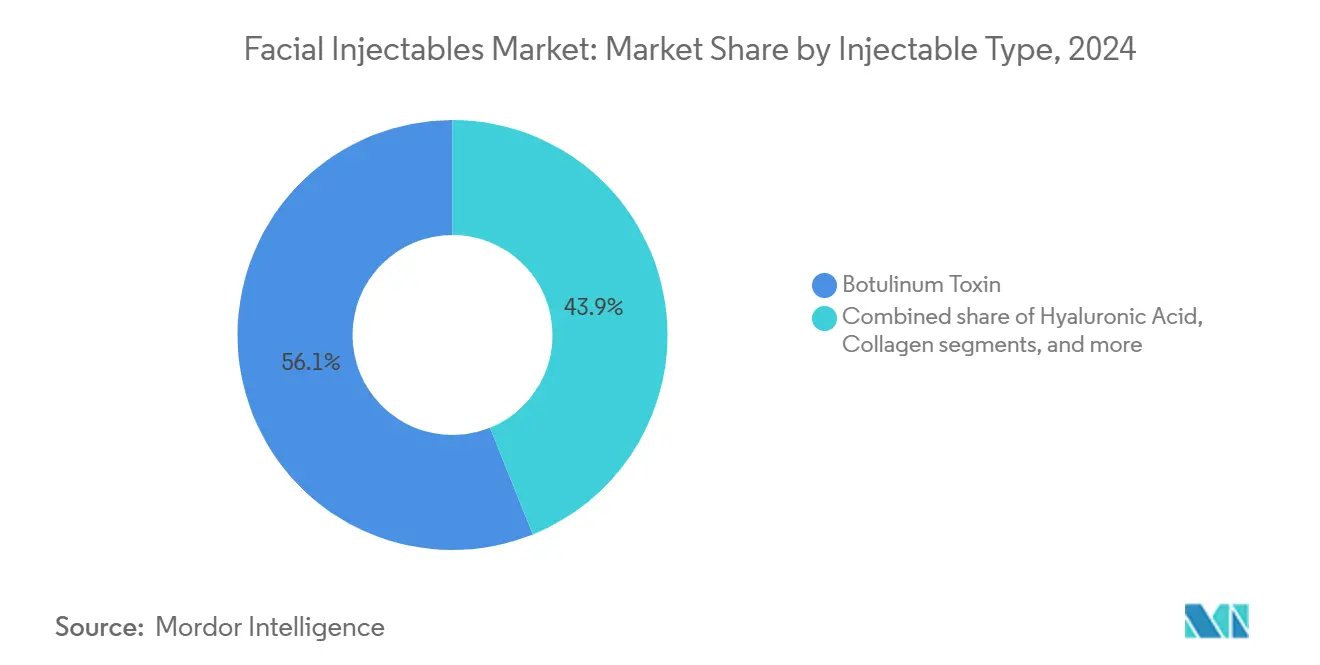
Note: Segment shares of all individual segments available upon report purchase
By Gender: Female users prevail while male uptake accelerates
Women accounted for 80.76% of 2024 procedures, underscoring longer historical adoption and higher social acceptance. Preventative treatment messaging and influencer marketing sustain steady clinic footfall.
Male procedure volume is rising 10.04% annually. Demand centers on subtle forehead relaxation and jawline refinement that preserve masculine features, often marketed as “personal grooming” rather than cosmetic change. Clinics are offering male-focused hours and marketing to capture this unmet slice of the facial injectables market.
By Application: Facial line correction dominates while face-lift surges
Facial line correction generated 32.63% of 2024 revenue, reflecting consumer priority on nasolabial folds and forehead lines that deliver visible rejuvenation in minutes. Combination protocols mixing neurotoxins with HA fillers further entrench this segment in the facial injectables market.
Liquid face-lift procedures, blending high-G’ fillers with neuromodulators to contour cheeks, jawline and temples, are expanding at an 11.18% CAGR. Practitioners leverage cannula techniques to reduce bruising and downtime, appealing to surgery-averse patients. Lip augmentation stays popular among younger adults, while acne scar and lipoatrophy treatments open additional paths for therapeutic growth inside the facial injectables industry.
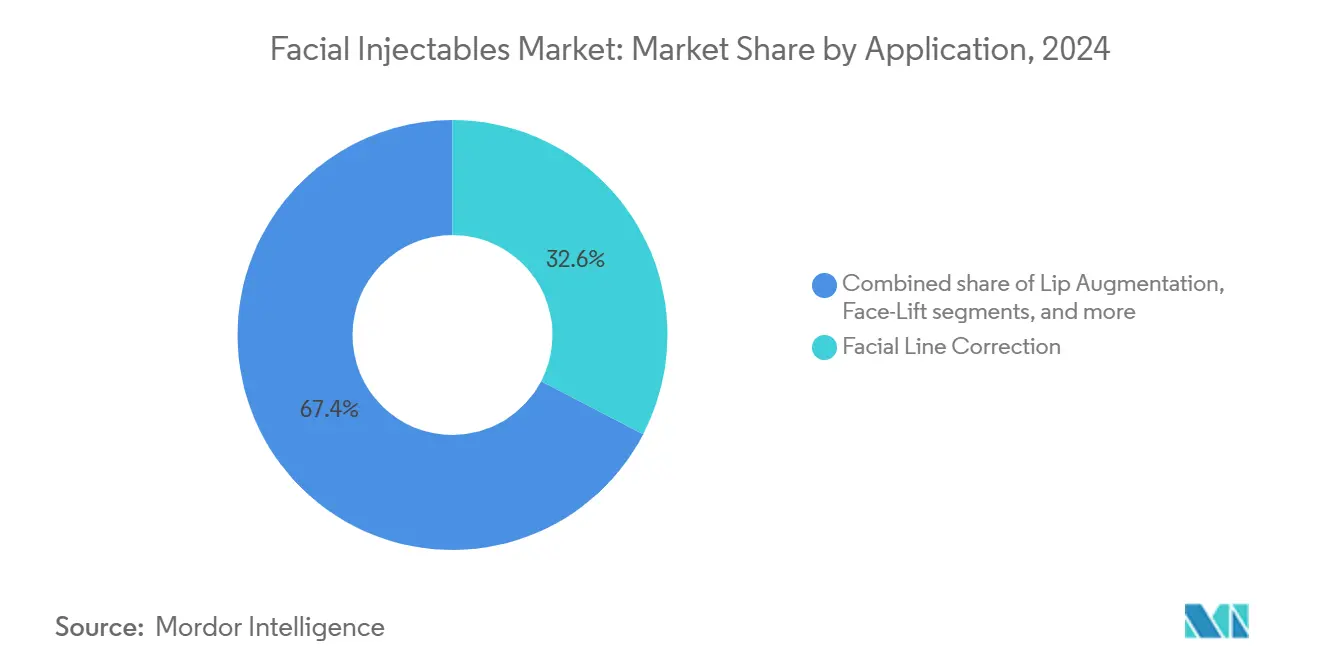
Note: Segment shares of all individual segments available upon report purchase
By End-User: Clinics & aesthetic centers retain majority while hospitals expand
Specialist clinics and aesthetic centers generated 54.32% of 2024 revenues, aided by flexible booking, bundled service packages and loyalty subscriptions that lift per-patient spend by 35%. Independent practitioners adopt CRM platforms to automate follow-up dosing reminders, keeping conversion rates high within the facial injectables market.
Hospitals and ambulatory surgical centers are recording a 9.51% CAGR as they diversify service lines. Their medical credibility attracts risk-averse patients for high-dose or therapeutic indications. MedSpas combine spa ambience with physician oversight, catering to experience-oriented consumers and adding choice to the overall facial injectables industry provider mix.
Geography Analysis
North America held a 38.75% revenue share in 2024, underpinned by 8,800+ medical spas and broad insurance coverage for certain therapeutic uses. The region’s 8.45% growth pace is moderated by economic headwinds and regulatory scrutiny of counterfeit products, yet product innovation and new indications keep procedure pipelines healthy.
Asia-Pacific is projected to reach double-digit 10.89% growth through 2030. Rising disposable income, pop culture focus on beauty and mature medical tourism ecosystems in South Korea and Thailand attract both regional and international clients. Local firms like LG Chem scale competitively priced fillers that grow the facial injectables market size without compromising quality.
Europe delivers an 8.81% CAGR, benefiting from sophisticated patient awareness and cohesive pan-EU training networks. Proposed UK licensing rules are likely to lift clinical standards and reinforce patient trust, sustaining expansion in the facial injectables market. The Middle East and Africa record 8.67% CAGR, propelled by Dubai’s positioning as a luxury cosmetic hub and growing urban affluent populations in Saudi Arabia and South Africa. South America advances 9.23% as Brazil’s culture of aesthetics and expanding insurance reimbursement for corrective procedures broaden access to injectables.
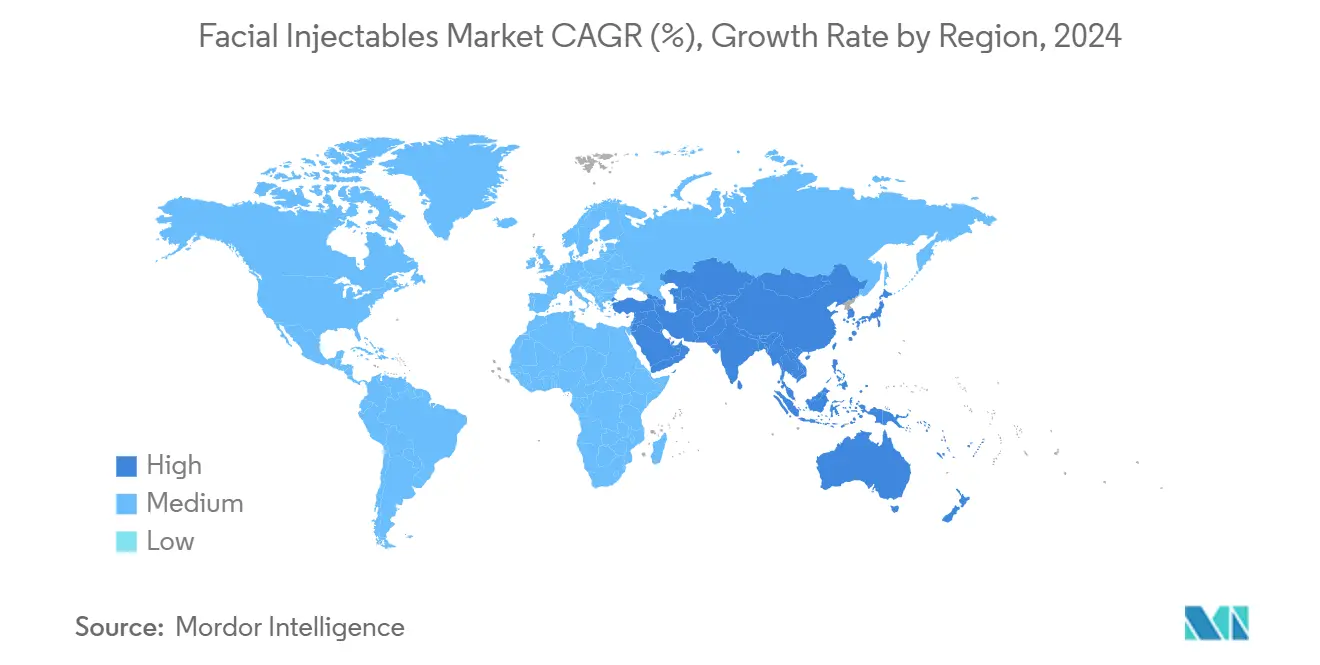
Competitive Landscape
Market leadership rests with AbbVie, Galderma and Merz Pharma, whose combined positions account for a dominant share of global revenues. AbbVie maintains category leadership with Botox and Juvederm yet saw a revenue dip amid loyalty program adjustments. Galderma posted record USD 4.41 billion sales in 2024, aided by portfolio depth and AR visualization tools that ease treatment planning.
Strategic consolidation continues. Crown Laboratories acquired Revance in February 2025 to secure Daxxify and the RHA filler range. Teoxane counter-offered Revance the following month, reflecting high demand for innovation pipelines that can differentiate within the facial injectables market.
Challenger firms such as Evolus grew Q4-2024 revenue 30% by targeting younger demographics with value pricing. Asian manufacturers including Huons Global accelerate exports, leveraging cost advantages and domestic clinical data to win share in emerging economies. White-space opportunities lie in developing injectables that merge regenerative properties with established neuromodulators, addressing consumer appetite for natural outcomes and fewer retreatments.
Facial Injectables Industry Leaders
-
AbbVie Inc.
-
Galderma SA
-
Ipsen SA
-
Merz Pharma
-
Revance Therapeutics Inc.
- *Disclaimer: Major Players sorted in no particular order
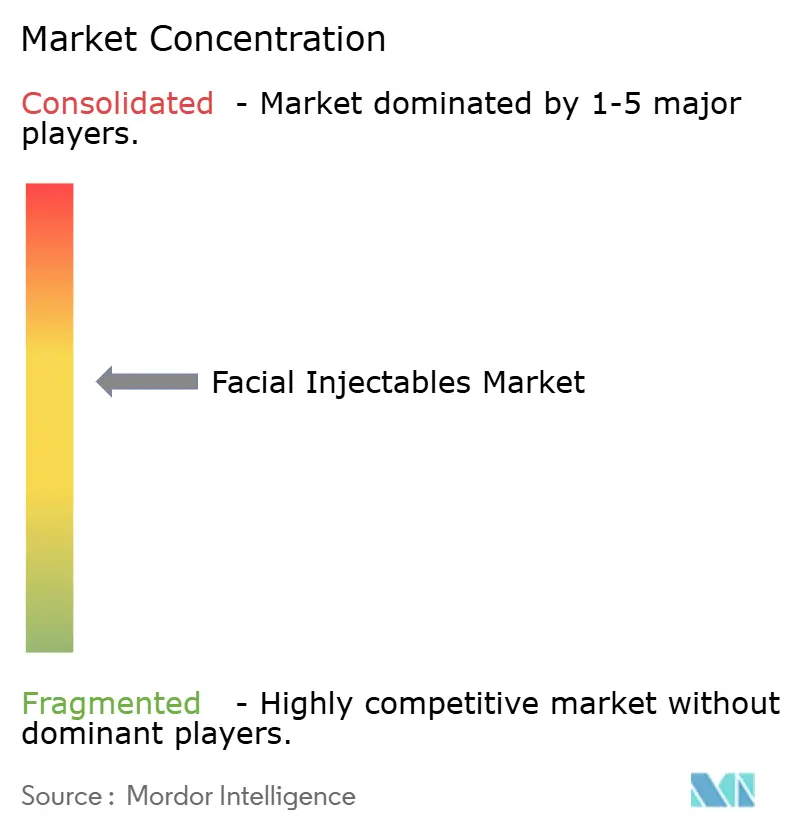
Recent Industry Developments
- April 2025: AbbVie submitted a BLA to the FDA for TrenibotulinumtoxinE, a serotype E toxin with eight-hour onset and 2–3 week duration.
- April 2025: BOTOX gained HSA approval in Singapore to treat benign masseter hypertrophy
- February 2025: Crown Laboratories completed the acquisition of Revance Therapeutics
- October 2024: BOTOX Cosmetic received FDA approval to treat moderate to severe platysma bands
Research Methodology Framework and Report Scope
Market Definitions and Key Coverage
Our study defines the facial injectables market as the global value generated by botulinum-toxin neuromodulators and dermal fillers, including hyaluronic acid, collagen, calcium hydroxylapatite, poly-L-lactic acid, polymethyl-methacrylate, autologous fat, and related biostimulatory gels, that are injected beneath the skin to restore volume, soften wrinkles, or enhance contours.
Scope Exclusion: purely surgical facial implants, energy-based devices, and topical cosmetics are outside this sizing exercise.
Segmentation Overview
- By Product Type
- Botulinum Toxin
- Hyaluronic Acid
- Collagen
- Calcium Hydroxylapatite
- Poly-L-lactic Acid
- Polymethyl-methacrylate (PMMA)
- Fat Injection
- Other Fillers
- By Gender
- Female
- Male
- By Application
- Facial Line Correction
- Lip Augmentation
- Face-Lift
- Acne Scar Treatment
- Lipoatrophy Treatment
- Other Applications
- By End-User
- Hospitals & Ambulatory Surgical Centers
- Clinics & Aesthetic Centers
- MedSpas & Others
- By Geography (Value)
- North America
- United States
- Canada
- Mexico
- Europe
- Germany
- United Kingdom
- France
- Italy
- Spain
- Rest of Europe
- Asia-Pacific
- China
- India
- Japan
- Australia
- South Korea
- Rest of Asia-Pacific
- Middle East & Africa
- GCC
- South Africa
- Rest of Middle East & Africa
- South America
- Brazil
- Argentina
- Rest of South America
- North America
Detailed Research Methodology and Data Validation
Primary Research
Mordor analysts spoke with dermatologists, plastic surgeons, aesthetic-clinic buyers, regional distributors, and raw-material suppliers across North America, Europe, Asia-Pacific, and the Gulf. These expert conversations verified average syringes per session, male client uptake, discount structures, and the speed at which new toxin indications translate into revenue.
Desk Research
We relied on open datasets from the International Society of Aesthetic Plastic Surgery, the American Society of Plastic Surgeons, Eurostat health accounts, and national customs portals tracking unit imports of toxins and fillers. Public 10-Ks, investor presentations, peer-reviewed journals such as Plastic and Reconstructive Surgery, and global news archives accessed through Dow Jones Factiva supplied launch timelines, list prices, and regulatory milestones. Company financial snapshots from D&B Hoovers helped align revenue splits with shipment volumes. The sources noted are illustrative; many additional references informed data collection, validation, and clarification.
Market-Sizing & Forecasting
A top-down reconstruction begins with country-level procedure counts, import values, and manufacturer revenues, which are then linked to average selling prices to establish the base year. Selective supplier roll-ups and clinic channel checks act as bottom-up cross-checks before totals are finalized. Key variables feeding the model include disposable-income index, Google Trends scores for "Botox" and "filler," injector-licensing density, approval cadence, and average syringe price erosion. Forecasts deploy multivariate regression blended with scenario analysis, so regional growth adjusts to income elasticity and regulatory change. Gaps in shipment data are bridged with clinic census and peer-market analogs.
Data Validation & Update Cycle
Outputs undergo variance checks, peer review, and anomaly flags within Mordor's workbook environment. We refresh the database annually, with interim updates triggered by material events such as novel toxin approvals or reimbursement shifts.
Why Our Facial Injectables Baseline Commands Reliability
Published estimates differ because each publisher chooses distinct product baskets, base years, mark-ups, and currency conversions.
By anchoring our model on verified procedure counts and triangulating them with trade flows and supplier disclosures, Mordor Intelligence delivers a baseline buyers can trust. Key gaps arise when other firms limit scope to fillers, fold therapeutic toxin sales into aesthetic spend, or roll forward older pricing without re-benchmarking.
Benchmark comparison
| Market Size | Anonymized source | Primary gap driver |
|---|---|---|
| USD 14.28 B (2025) | Mordor Intelligence | - |
| USD 9.54 B (2024) | Global Consultancy A | Excludes neuromodulators; older pricing base |
| USD 12.53 B (2024) | Industry Database B | U.S. surgery census extrapolated worldwide; limited country granularity |
| USD 18.31 B (2025) | Market Publisher C | Includes therapeutic toxin revenue and distributor mark-ups |
The comparison confirms that our disciplined scope, refreshed base year, and dual validation steps provide a balanced, transparent market view that is traceable to clear variables and repeatable logic.
Key Questions Answered in the Report
Why are facial injectables becoming popular with Gen Z consumers?
Social-media platforms have normalized “Baby Botox,” making subtle, preventative treatments socially acceptable and prompting younger adults to seek neuromodulators earlier than previous generations.
How do subscription-based MedSpa programs affect provider economics?
Membership models create predictable, recurring revenue streams and tend to lift average client spending because bundled perks encourage more frequent treatments and product add-ons.
What makes lidocaine-enhanced hyaluronic-acid fillers attractive to clinicians?
Integrated lidocaine reduces injection pain, shortens chair time and improves patient satisfaction, allowing practitioners to treat more clients per day without compromising care quality.
Which regulatory shifts could reshape market competition?
Proposed mandatory licensing in markets such as the UK and tighter U.S. oversight of medical-spa settings aim to raise safety standards but may temporarily restrict the pool of qualified injectors.
How is medical tourism influencing demand patterns for injectables?
Cost advantages and well-publicized centers of excellence in destinations like South Korea and Mexico draw international patients, concentrating high procedure volumes in regional hubs and spurring local innovation.
What new product category is expanding the injectable portfolio beyond neurotoxins and fillers?
Regenerative injectables, including polynucleotide formulations, are gaining momentum by promising tissue repair and natural-looking results, thereby diversifying treatment options for practitioners and patients alike.
Page last updated on:



